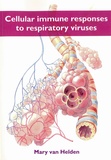Cellular immune responses to respiratory viruses
Summary
When a respiratory virus successfully infects the lungs, cascades of immune responses are initiated aimed to remove the pathogen. Immediate non-specific protection is provided by the innate immune system and this reduces the viral load during the first days of infection. The adaptive immune response is pathogen-specific but takes several days to develop during primary infection. In her thesis entitled ‘Cellular immune responses to respiratory viruses’, Mary van Helden studied several fundamental aspects of immune responses to respiratory viruses in mouse models. For her studies she used influenza virus, human respiratory syncytial virus (RSV) and its natural rodent-specific variant pneumonia virus of mice (PVM). Natural killer (NK) cells are members of the innate immune system and play an important role during respiratory virus infections. In her thesis, Mary van Helden showed that respiratory virus infections induce migration of NK cells from remote storage sites to the airways, resulting in increased quantities of NK cells in the airways. NK cells from influenza virus infected mice were, compared to many other members of the innate immune system, extremely long-lived. These long-lived NK cells were shown to proliferate in the bone marrow in absence of infection and upon respiratory virus infection. Whether these long-lived NK cells can memorize respiratory viruses, as recent literature has indicated for other viruses, requires further investigation. However, the results presented in her thesis suggest that the bone marrow might be crucial for maintaining long-lived NK cells. Although intranasal infections with influenza virus or RSV induced rapid early innate immune activation, Mary van Helden showed that this innate immune activation was relatively late in PVM infected mice and that early innate immune activation prevented severe PVM-induced disease. Furthermore, in contrast to causing pathology during primary infection, the early presence of PVM-specific CD8 T cells prevented severe PVM-induced disease. In conclusion, these results show that upon PVM infection, early reduction of viral load is essential for preventing T cell-induced severe pathology later, which can be mediated by PVM-specific CD8 T cells. Some viruses downregulate MHC class I to prevent elimination by CD8 T cells that recognize infected cells via this molecule. NK cells recognize the absence of these MHC class I molecules and therefore eliminate virus-infected cells that have downregulated MHC class I expression. Mary van Helden showed that mice that lack immunoproteasomes have lower MHC class I levels. She furthermore showed that splenocytes of immunoproteasome-deficient mice were not attacked by NK cells in naïve mice, but infection led to NK cell mediated rejection of these immunoproteasome-deficient cells. These results show that infection can induce NK cell-dependent rejection of an otherwise tolerated graft. In conclusion, the results presented in her thesis increase our knowledge about the ‘indirect’ role of immunoproteasomes in ‘tolerance versus reject’ decisions by NK cells in transplanted host. The results furthermore help to better understand the role of the immune system during respiratory virus infections and might therefore contribute to the development of new and safe drugs and vaccines to treat and/or prevent respiratory virus infections.
